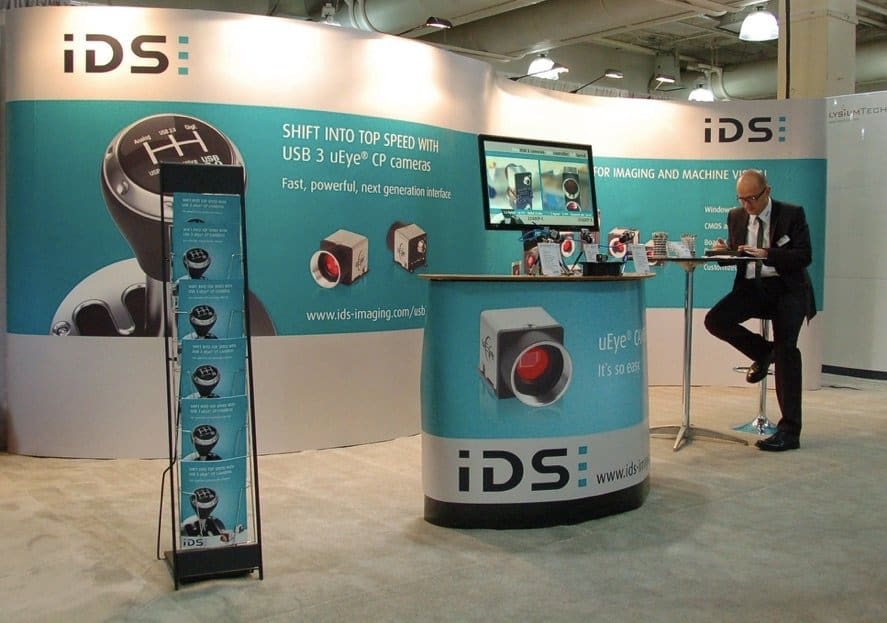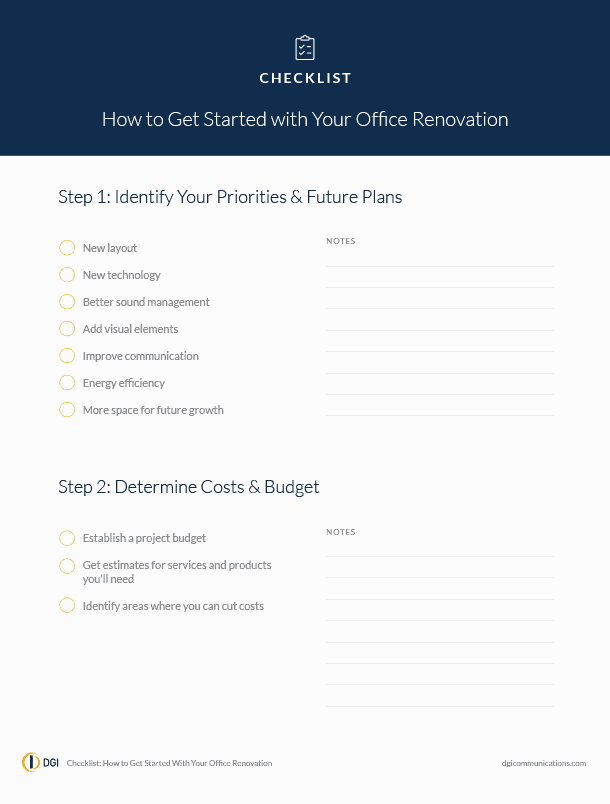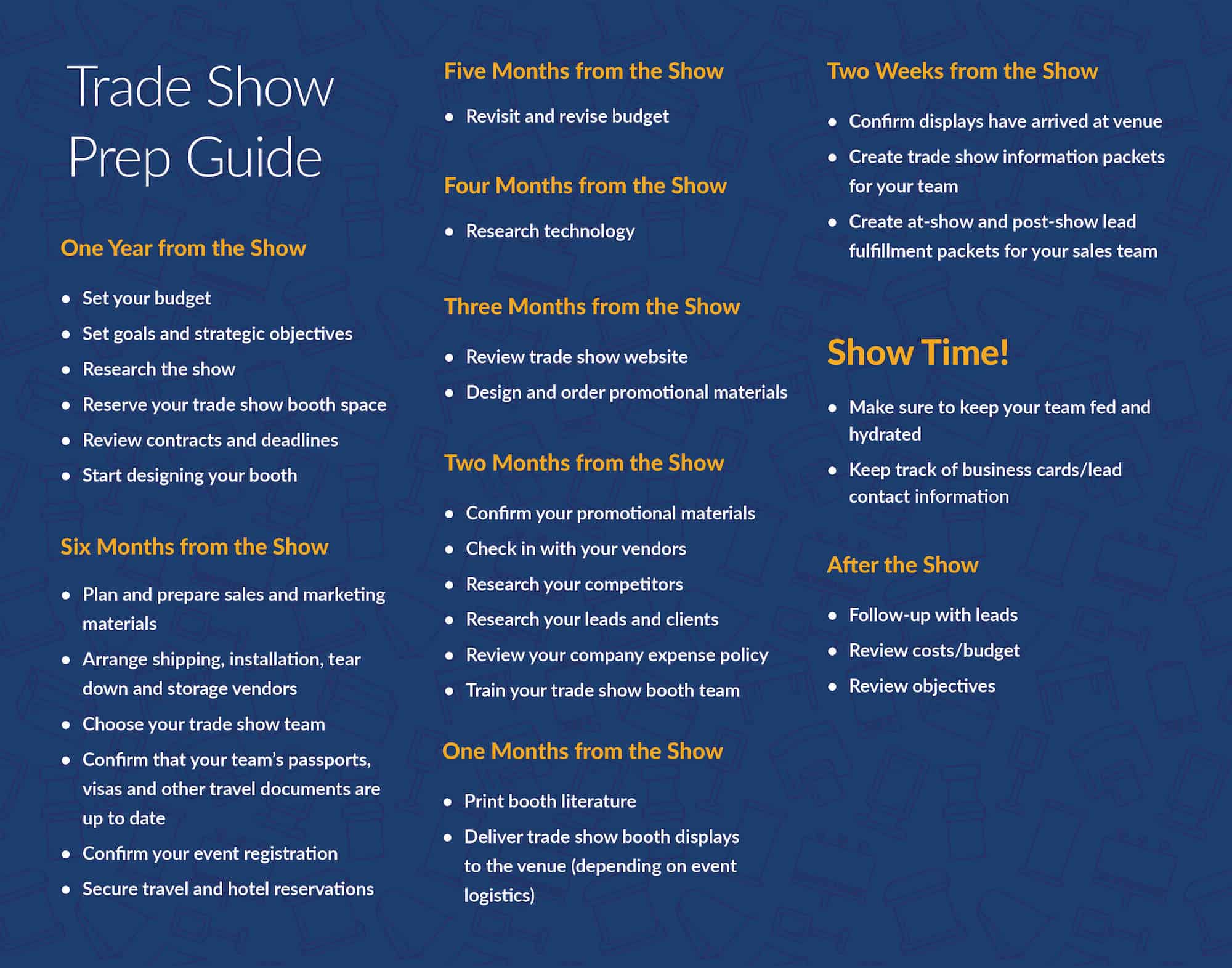Every year, companies large and small attend trade shows to connect with new and existing clients. The investment of time and money can be substantial but, if done right, can lead to significant business opportunities. Even though digital and virtual events are more common these days, there is no substitute for face-to-face interaction. We’ve put together a comprehensive guide to make your trade show booth design engaging and effective.
Brand Your Display Space
At a trade show or conference, you and your booth should always stand out. Ensure that your trade show booth branding is memorable, from signage to design.
Here are some trade show display tips:
- Use durable materials for your displays so that they are long-lasting and able to withstand travel.
- If you just need a one-time display, Fold N’ Go stand-up displays are affordable and recyclable.
- Brand everything around you, including promotional items, like pens and other giveaways.
Creativity Is King
Signage creates the first impression of your brand on the trade show floor. Don’t just roll out a tired booth with decades-old graphics. Create eye-catching visuals that draw attendees in. Even on a small budget, fresh graphics and updated paneling or displays draw potential clients’ eyes. The money spent on booth space and staffing will be wasted if you skimp on visual elements. Invest wisely in your trade show booth by making your display vibrant and clear.
With a few creative stunts, you can shine among fancy pop-up displays and expensive exhibits on a very limited budget.
Here are a few examples:
- Set up a fun competition to tempt passers-by, like a ring-toss competition for bottles of wine.
- Use foliage to create an outdoorsy/tranquil feel inside.
- Implement unique design areas like fabric architecture, repurposing a vintage vehicle, having your booth be in the shape of an object or hanging an object above the booth (if possible).
Just make sure to clear any stunts or out of the box ideas with the venue, as some ambitious strategies may not be allowed.
Create an Interactive Experience
One of the best ways to attract people to your booth is to offer a way for attendees to see and feel your products and services.
You can do this by immersing them into your brand through a combination of print and technology techniques. Some options can include:
- Product demos
- Interactive digital signage
- Presentations on tablets or flat screens
- Audio and visual messaging
There will be a lot of customization with an interactive experience, so be sure to start the planning process early and work with an experienced vendor like DGI if you choose to take this route.
Offer Contests & Giveaways
Who doesn’t like winning prizes? A great way to attract people to your booth is to offer something they can engage with. Some type of game or contest will pique the interest of attendees, especially if they can win something.
When people are attracted to your booth, it’s an opportunity for you to start a dialogue with them that can become a valuable connection.
Contests can include something simple like drawing a business card, or you can get more creative with a game related to your company’s products or services. Make sure to spread the contest out over the course of the day. Then, you can tell people to come back to your booth at a certain time to find out if they won. This will keep your company and your trade show booth in their mind throughout the entire day.
If a contest isn’t your style, you can give away branded freebies. Add your company logo to products related to your industry, like a cell phone charger for a telecommunications conference or a laptop case for a digital marketing trade show. Even the tried-and-true candy bowl is known to drive traffic to booths.
All About “Swag”
“Swag” or branded promotional materials are a must-have for any trade show booth. In fact, 83% of people are more likely to do business with a brand that gave them a promotional product. The most popular promotional items are apparel, drinkware, writing utensils, bags and wallets, and home/office supplies.
The more creative you can get with an item, the more memorable it will be. Here are a few common “swag” items:
- T-shirts
- Tote bags
- Masks/hand sanitizer
- Hats
- Mints
- Pencils/pens/notebooks
- Pop socket
- Journals
- Water bottles
- Mobile chargers
Don’t Ambush, Invite
Popping out from your booth only to force attendees into a conversation is a surefire way to lose a potential client. Being proactive, friendly and approachable is key, along with giving attendees a reason to stop by.
CEIR found that 59% of trade show attendees prefer interactive demonstrations. Some examples of this can include:
- Chair massages
- A putting green
- A shoe shining station
- Games
- Promotional giveaways
If you do have promotional items to give away, they’re even better when won by spinning a wheel, sinking a putt or landing a ring on a bottle (again, check with the host to see what’s possible). People love winning, and they’ll remember your brand if they had fun playing.
Let people feel your presence and have fun! Nothing beats being friendly and generous. Sticking around for networking after-parties and impromptu gatherings at the bar or lounge can often land the best prospects.
Tip: Don’t let ego or your competition lead you into overspending to acquire massive booth space or sponsorships when you can build great relationships in a breakout suite or cocktail hour. A smaller booth with catchy signage — like an LED video wall along with an after-hours private suite or reception — can open the door to quality conversations and opportunities at the same or lower cost as a big booth.
Staff Your Booth Strategically
Your booth’s staff represents your company’s image and aptitude. They need knowledge and energy. Company ambassadors should not only provide competent answers to booth visitors but be active and engaging hosts in your space.
Here are some tips:
- Sending your best salesperson from another region may work better than choosing a less outgoing local employee. Better yet, send a dynamic team to make sure you have adequate coverage — a lunch or bathroom break could mean a missed opportunity.
- Initial outreach lays networking groundwork. Take the time to research the attending list if possible. Send potential contacts a personal email or connect on LinkedIn to let them know that you’d love to meet them at the upcoming event.
- Unshackle yourself from the display. The connections you make in the hallway may introduce you to potential clients, so get out and engage with your fellow sponsors.
And of course, don’t forget to follow up after the trade show. Nurture these new business relationships.
How to Market Your Trade Show Booth
A few weeks before the event, make sure to reach out to your prospects and clients to let them know you’ll be attending. You can do this by marketing yourself before the event even begins through:
- Email marketing campaigns
- Social media posts
- Temporary website announcements
Inviting your best clients to an event is like having living testimonials walking around on behalf of your brand. Don’t forget to extend a personal invite to them! Are there high value prospects in attendance? Maybe plan a private cocktail hour where you invite them along with your best customers can drive sizable, future business.
Start Prepping Early
A lot of work goes into planning and attending a trade show — especially if it’s one that requires traveling and shipping items. But even if you think your trade show displays and associated items will be easy enough to put off until the last minute, you can still run into delays, errors and other issues.
Follow Up with Leads Soon After the Event
We all like to think that we leave a lasting impression. But the truth is that the longer you wait to follow up with leads, the better chance there is that they’ve completely forgotten about you.
Ideally, you should be setting up meetings with prospects during the event, but that doesn’t always work out. Follow up a day or two after the show, once everyone is likely settled back at home and ready to move forward.
Trade Show Branding Best Practices
Before you start designing the custom trade show display of your dreams, you should know:
How Much Space You Have
Have the dimensions of your trade show space in mind before you start getting creative with the display. A 10×10 booth won’t have the flexibility that a 20×20 booth will offer — and the last thing you want is to cram a ton of items into a small space. You can better visualize your space by taping the measurements on the floor of a conference room or large area in your office so you’ll have a better idea of your limitations.
What Your Budget Is
Just as there will be spatial constraints, you’ll want to be conscious of your budget limitations from the very beginning.
Who Will Set Up the Booth
If there will only be one or two people from your company setting up the trade show display, it will need to be relatively simple to assemble. If there will be a team of people ready to help, then you can get a bit more creative. Most conferences offer on-site set-up assistance for a fee, but you’ll need to book in advance.
Your Timeframe
The tighter your deadline, the more limited you may be. Detailed customizations will take longer than simply displays, so prepare well ahead of time if you’re planning on a more complicated exhibit.
How Often You’ll Use the Display
There’s a big difference in the production process if you’re going to be using a banner just once vs. multiple times. The frequency with which you expect to use the display will determine the type of materials they need to be made of.
Once the logistics are figured out, you can get to the fun part: brainstorming the design. There’s an endless amount of event signage options available, some of which include:
- Banner stands
- Self-standing displays
- Branded tents (for outdoor exhibits)
- Hanging banners
- Wayfinding signage
- LED-powered, high-resolution displays
Ultimately, your exhibit needs to be approachable and welcoming to all attendees. Also, be sure to bring and display supportive materials like flyers, brochures, marketing materials, business cards and anything else that conveys your industry expertise.
To maximize success, your displays and presence should fit with your brand as well as the industry. A trade show is a substantial investment, so make sure you make the most of it.
There’s a lot of thought and strategy that goes into planning a successful trade show booth. You can always reach out to our team for help with design, production or custom branding experiences for your next trade show. We’re happy to help you knock it out of the park!


